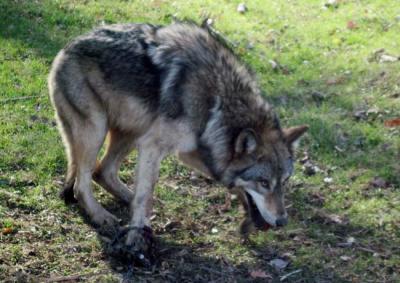Got the following in an email
This gray wolf was caught by a coyote trapper just outside of Rochester, Minn., over the weekend. It was later released unharmed by Minnesota Department of Natural Resources officers. Gray wolves on occasion show up in southeast Minnesota, and biologists they are are lone travelers coming from Wisconsin. (Minnesota Department of Natural Resources)A gray wolf weighing an estimated 80 pounds was caught by a coyote trapper outside of Rochester, Minn., last weekend. With the exception of a sore paw, it was released unharmed by state Department of Natural Resources conservation officers.
Gray wolf reports are increasingly common in southeastern Minnesota, which is outside their normal breeding range. But biologists don’t believe the animals are breeding or establishing packs in the region.
“I think this (report) is unique,” said Dan Stark, wolf expert for the DNR. “It’s consistent with a disperser, like the others that have shown up before.”
Conservation officers received a call from the trapper, and they found the wolf alive in the trap.
“A coyote trapper called after he realized it wasn’t a coyote in his trap,” Lt. Dean Olson, DNR enforcement supervisor for southeastern Minnesota, wrote in an e-mail. “We did release the wolf on site. He appeared to be fine, just tired.”
Minnesota has about 3,000 gray wolves, but they typically live and breed in the northern third of the state in the forested region. In 2009, animal welfare groups successfully petitioned a judge to put Midwest gray wolves back on the endangered species list. The Minnesota DNR recently petitioned the U.S. Fish and Wildlife Service to have the animals removed from the list, and the federal agency has until March to make a decision.
Stark said it was likely that gray wolves in southeastern Minnesota originate in Wisconsin, rather
than northern Minnesota, because there are wolf packs established just 75 miles east of Rochester. Stark said gray wolves would be able to cross the Mississippi River during winter.
Stark said he has heard of wolves killed accidentally each of the past three winters in southeastern Minnesota. He said “there is the possibility” wolves could establish breeding populations in the southeast, but maintaining a population might be difficult, given the number of highways and potential conflicts with humans.

 hopefully someday soon
hopefully someday soon